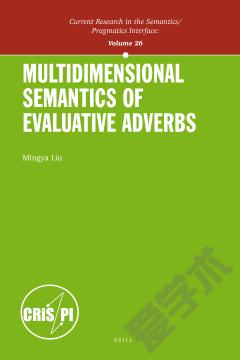Multidimensional Semantics of Evaluative Adverbs
Acknowledgements Abbreviations Notation conventions 1 Introduction 2 Evaluative Adverbs, Conventional Presuppositions and Conventional Implicatures 2.1 Introduction 2.2 EADVs and CIs 2.2.1 A Non-truth-conditional Approach and its Problems 2.2.2 Semantic Duality and Assertoric Asymmetry 2.2.3 A Two-dimensional Approach and its Problems 2.3 EADVs and CPs 2.3.1 The Undefinedness of At-issue Contents 2.3.2 The Undefinedness of CIs 2.4 The Projection Problem of EADVs 2.4.1 The Embeddability of EADVs 2.4.2 The Projection of EADVs in Conditionals 2.4.3 Supplements that do not Project 2.5 Summary of the Chapter 3 A Logic for Conventional Presuppositions and Conventional Implicatures 3.1 The Dimensions of CPs and CIs 3.2 LCI (Potts, 2005) 3.3 LCP/CI 4 The Positive Polarity of EADVs 4.1 Introduction 4.2 The Distribution of EADVs 4.2.1 EADVs and Negation 4.2.2 EADVs and Modals 4.2.3 EADVs and Questions 4.2.4 EADVs and Conditionals 4.2.5 EADVs and Other contexts 4.3 A Polarity Approach to EADVs 4.3.1 Negative Polarity Items 4.3.2 Positive Polarity Items 4.3.3 EADVs as PPIs: Experimental Evidence 4.3.4 Non-veridicality Account 4.4 A Projection Approach to EADVs 4.4.1 EADVs in LCP/CI 4.4.2 EADV Ordering 4.5 Summary of the Chapter 5 The Subjective Meaning of EADVs 5.1 Introduction 5.2 Predicates of Personal Taste (PPTs) 5.2.1 Two Kinds of Vagueness 5.2.2 Previous Analyses 5.2.3 Kinds of (Dis)agreement 5.3 EADVs 5.3.1 Three Kinds of Vagueness 5.3.2 Analysis 5.3.3 Embedded EADVs 5.3.4 Quantified Judges 5.4 Summary of the Chapter 6 Conclusion, Problems and Outlook References Appendix
{{comment.content}}








 京公网安备 11010802027623号
京公网安备 11010802027623号